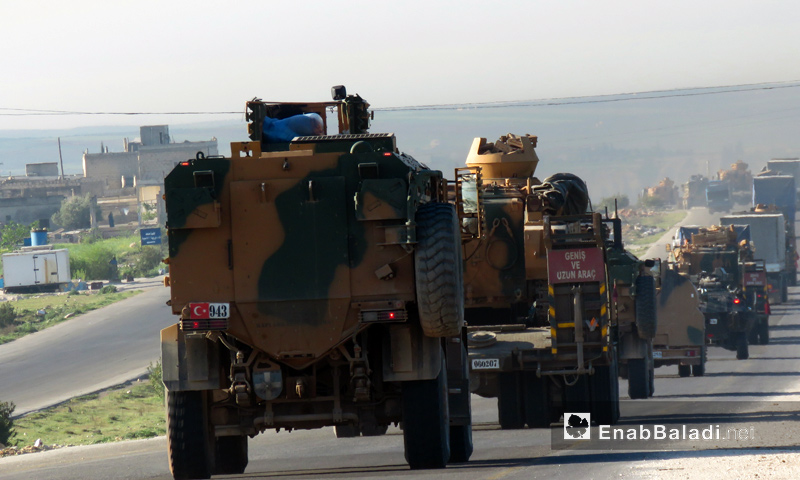



The civilians, in the opposition-held areas, count on the international understandings to achieve some stability, after years of continuance battles and shelling.
Turkish forces have settled in Rural Hama for the first time on the 7th of April, in the area of Dahret Maysalun, in the east of the city of Murak, which used to be an Assad’s forces checkpoint, but the opposition managed to control it.
Before rural Hama, the Turkish army started spreading its forces in Idlib governorate, seeking to install monitoring points as to observe the cease fire in the areas under the “de-escalation agreement,” which has been sealed in Asatana, with Russia and Iran, the cease fire guarantors.
With the installation of the Turkish point in rural Hama, there would be eight monitoring points in northern Syria, which is held by the opposition.
The Turkish forces entrance to rural Hama was accompanied by a state of optimism among civilians, who hope that the constant shelling by Assad’s forces and the Russian air forces would stop.
The Head of Murak Town’s Consultative Council Ausama Abu Jada’n told Enab Baladi that rural Hama was lately suffering a dense and a crazy shelling, which led to the displacement of most of the people towards the north.
“The shelling has also caused an acute damage to the infrastructure, the absence of services and a massive decline in industry and agriculture,” Abu Jada’n added.
The military leader in the “Free Army,” from the city of Murak, Mohammad Abu al-Zahraa stressed that a portion of rural Hama’s people were displaced due to the continuance violent shelling by the regime, its alley militias and the Russian air forces, before the arrival of the Turkish point.
In a report issued in mid-December 2018, UN estimated that, in a month, 6700 families were displaced from the northern countryside of Hama, the southern countryside of Idlib and the western countryside of Aleppo.
The shelling on the area has declined after the Turkish point was installed in the east of Murak, according to Abu Jada’n, especially in the areas surrounding the point, such as Murak, which helped some people return to the city and start preparing their houses to live there upon feeling some sort of security.
However, the shelling is yet constant on the two cities of Kafr Zita and al-Lataminah, and the villages between them. But Abu al-Zahraa has pointed to a decline in the number of the aircraft’s sorties in the area to half what it used to be.
The economic and the social situation is witnessing a gradual improvement after the people’s return to their agricultural, industrial and commercial life in the city of Murak, according to Abu Jada’n; however, it is yet early to speak of an improvement in the economic reality prior to stability that would last for months at least.
Abu al-Zahraa believes that the economic situation has been deteriorating before and after the installation of the Turkish point, with the exception of some service-related activities, such as clearing the roads of rubble.
As for the agricultural sector, it witnessed a marked improvement, taking into consideration that farmers are unable to reach large spaces of their farm lands.
But the Turkish presence has helped the farmers arrive at their lands and has activated the reconstruction and restoration in Murak, which generated many job opportunities.
Farmer Mohammad al-Aboud, from the city of Murak, whose land is located near the Turkish Base, told Enab Baladi that the farmers have returned to their lands after three years of absence, for they could rarely reach to them because they were close to the regime’s checkpoints that targeted them.
It was rumored that the land upon which the Turkish base was created has been donated by Mustafa al-Fawaz, one of the area’s farmers.
But al-Fawaz assured Enab Baladi that he did not donate his land; rather, he gave it up according to a contract to be signed in a week’s period; the Turks will pay him a compensation for using his land, pointing out that it has been negatively affected because of the earth mounds.
Al-Fawas has also mentioned that the agricultural sector has witnessed a marked action after the construction of the base, pointing out that farmers used to reach their lands before and that Assad’s forces often targeted the heavy tractors, not the farmers if they were alone.
After the popular and the Hama Governorate Council’s appeals, fearing the progress of Assad’s forces, early in April, a Turkish delegation examined areas in the northern countryside of Hama, prior to the installation of the base in the east of Murak, including the city of al-Lataminah, Tal Fas, Latmin, and the village of Kafr Nabudah; it also spotted Tal Osman and areas in al-Ghab Plain in the western countryside of Hama.
The destiny of the upcoming Turkish military bases in the area is so far indefinite, while al-Ghab Plain in the western countryside of Hama has witnessed the positioning of Russian forces between the two towns of al-Rasif and Shatha, which are controlled by the Syrian regime.
if you think the article contain wrong information or you have additional details Send Correction